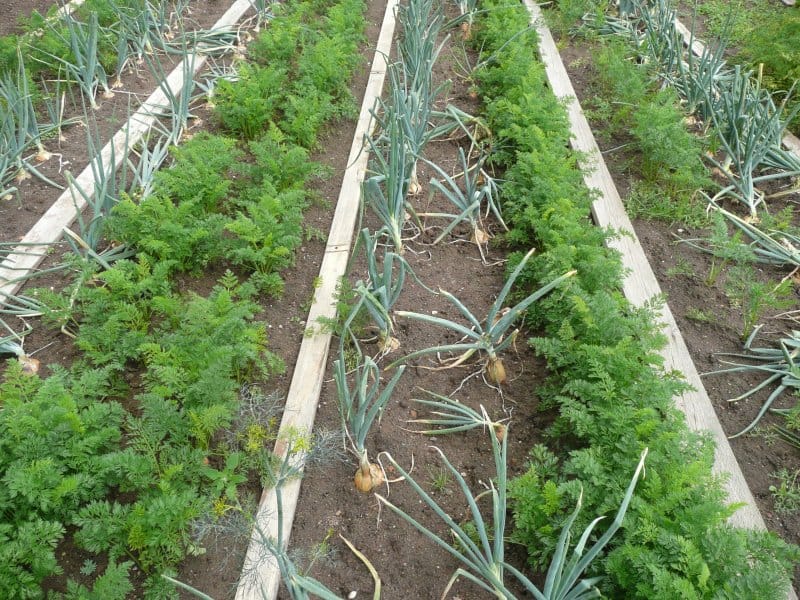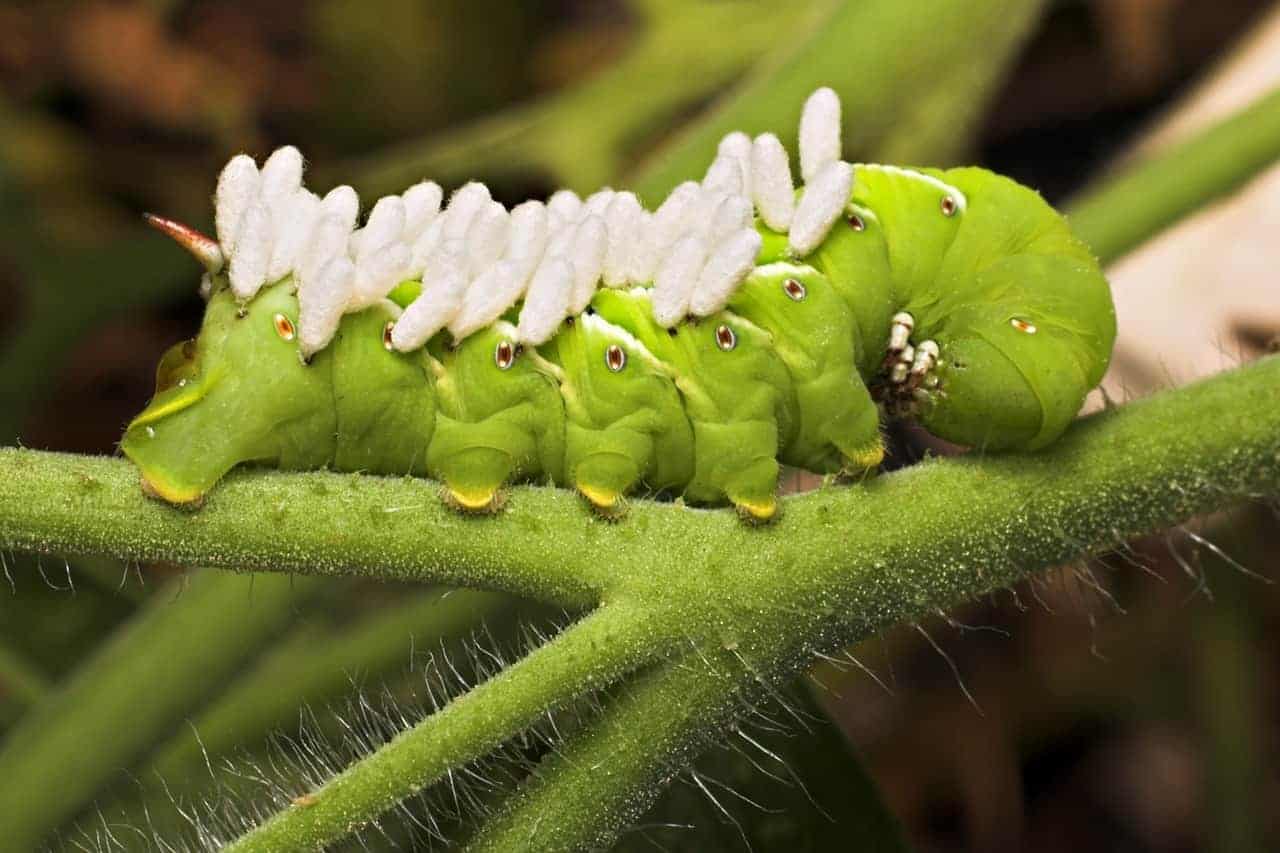If you’re thinking of what you could plant with your tomatoes to fill in the gaps in your tomato bed, you have a lot of options.
You may have heard that planting basil next to tomatoes will make your tomatoes taste better. While that hasn’t been proven in studies, you should still consider planting basil with your tomatoes.
In fact, there are several benefits of planting flowers or other vegetables with your tomatoes, but you have to know which ones will actually thrive and benefit your garden.
When choosing what to plant with tomatoes, consider what vegetables or flowers are less likely to compete with or be outcompeted by tomato plants. Vegetables with shallow root systems, those that stay small, grow well in partial shade, or have few large leaves are good choices for tomato plants. Examples of vegetables that grow well next to tomatoes are lettuce, spinach, green onions, garlic, carrots, Swiss chard, radishes, and non-spreading herbs like basil. Planting flowers and flowering herbs like marigolds and dill near your tomatoes can also attract beneficial insects like pollinators and predatory insects.
On this page:
What is Intercropping and Companion Planting?

Intercropping and companion planting are similar concepts. Intercropping (also called interplanting) is an agricultural term meaning to grow two or more crops close together within the same field.
A traditional example of intercropping is the “Three Sisters” method of farming developed by Native Americans, interplanting corn with beans and squash. The corn acts as climbing poles for beans, which replenish nitrogen to the soil, and the squash act as a ground cover. Modern commercial examples would be farmers growing annual crops among their perennial shrubs and trees.
Companion planting can be considered a type of intercropping, but specifically to grow two or more types of plants together in a way that both benefit each other specifically when planted together instead of being planted separately.
Benefits of Intercropping and Companion Planting
Maximizing Space
The most common use of intercropping is to maximize space in your garden. If you are growing perennials, you may have space around them to plant other vegetables.
For example, after I transplanted one of my fig trees into a larger pot, I had lots of space along the edge to plant a line of green onions without competing for nutrients with the fig tree.
Another example just from this year was when I planted Swiss chard in front of my tomatoes. Swiss chard doesn’t have deep, sprawling roots, so they didn’t compete with the tomatoes, and while they did receive full sun in the morning, the tomatoes offered partial shade in the afternoon. In previous years, I’ve also planted green onions in the spaces between my tomatoes.
Lettuce is another vegetable that grows well on either side of a row of tomatoes.
Trap Cropping
Another use of intercropping is called trap cropping, which uses plants that specifically attract pests away from your main crop. This has been used successfully in home gardens but as far as I know, it’s not used for tomatoes.
For example, use nasturtiums to draw cabbage moths and small white butterflies away from cabbage family vegetables (kale, broccoli, cabbage, etc.). Those moths and butterflies prefer laying their eggs on nasturtiums, therefore protecting your other vegetables.
This can also be used with different varieties of the same vegetable. There are some varieties of squash which are more attractive to pests such as squash bugs and vine borers. You can plant them away from your main squash, which will draw the bugs toward the trap squash. This also can be used to concentrate them in a smaller area so you can spray them with organic insecticides, too.
It’s best to use trap cropping when you know that you already have a recurring pest problem.
Pest Confusion

The opposite of trap cropping is using companion planting to confuse pests. Pests are attracted to the sight and scent of your vegetables.
Growing a large field of one single vegetable (called a monoculture) that is like a bat signal for pests. In the same vein, having a row of vegetables sitting alone, surrounded by bare soil, mulch, or low-lying grass is also very easy for flying pests to identify and attack.
Research has shown that flying pests have a more difficult time navigating around potential host plants that are surrounded by other plants. A good review of this research was conducted at the Horticulture Research International in the UK [PDF].
Science has partially busted the myth that pest insects avoid aromatic plants like herbs. The authors conclude (so far) that any plants that pests don’t target can effectively confuse them when interplanted with your vegetables.
Why it works is that when flying pests will fly or flutter around their target plants, and periodically land on them to eat or lay eggs. But, for example, if a cabbage moth lands on a kale leaf, then flies a few inches and lands on a pepper leaf, then flies a few inches and lands on another pepper leaf, then a kale leaf, then on an onion leaf, it may get confused and think it’s not on the right plant, and fly away, laying few or no eggs.
Just make sure that those plants don’t all attract the same pest. Interplanting broccoli next to your cabbage and radishes won’t prevent cabbage worms and cabbage loopers – they are all in the same family and will all attract those annoying small white butterflies and cabbage moths. But planting a cabbage in the middle of a bed of Swiss chard or cilantro may confuse wandering pests.
The key takeaway is that planting different fruits and vegetables together can make it harder for pests to find their favorite host plants.
Attracting Beneficial Insects
You can also use companion planting to attract beneficial insects, such as pollinators.

Having pollinators visiting your tomatoes means an overall higher fruit set without you having to manually shake or vibrate the tomato flowers.
Pollinators aren’t the only beneficial insects in your garden. Attracting predatory insects – insects that kill other insects – can make the difference between having a hands-free bountiful harvest and struggling every week to control pest damage.
Tomatoes have one common devastating pest, the tomato hornworm, which is very difficult to see but can quickly defoliate a tomato plant within a few days. Most gardeners don’t even know they have hornworms until they start seeing entire leaves missing and dark green caterpillar poop fallen on the branches.
Hornworms love tomatoes, but parasitic wasps love hornworms. They lay their eggs on the back of hornworms, which eventually hatch and then eat the hornworms from the inside. Parasitic wasps themselves don’t actually eat the hornworms, only their young do, but they do feed on nectar and pollen, so planting flowers can help attract beneficial wasps to control your garden.
The NC Cooperative Extension has written in more detail about attracting parasitic wasps to your garden.
Best Vegetables to Plant with Tomatoes
Now that we’ve covered the basics of intercropping and companion planting, we can start to figure out what are the best (and worst) things to plant with tomatoes.
Any plants which stay relatively small and have smaller root systems can be planted with tomatoes. Don’t plant them between tomato plants; instead plant them on either side of them, so they don’t get completely shaded out by the tomato plants. Ideally, you would plant them on the north, east, or west side of your row of tomatoes, as planting on the north side might be too shady.
Vegetables that you can use to maximize space in your tomato bed include: lettuce, spinach, Swiss chard, green onions, garlic, radishes, and beets.
If you are interplanting flowers to attract beneficial wasps and pollinators, many non-sprawling herbs such as rosemary, thyme, cilantro/coriander, parsley, fennel, caraway, and dill will work. Marigolds are an excellent addition to the garden that can attract pollinators as well as predatory insects. Other beneficial flowers include pennyroyal, Zinnias (especially the ‘Liliput’ variety), and tansies.
What to Avoid Planting with Tomatoes
Avoid growing large plants with your tomatoes. This goes without saying, but planting any vegetables that will compete with your tomatoes for light and nutrients will lead to smaller harvests of both. For instance, don’t plant sunflowers or cucumber plants right next to your tomatoes. Whichever grows faster will end up outcompeting the other.
The only exception I know of is growing beans with tomatoes, as long as the beans are planted on the north side of your row of tomato plants. That way when your beans are fully grown, they aren’t shading out the sunny south side of the tomato bed.
Avoid plants in the nightshade family (peppers, eggplants, potatoes, tomatillos, etc.) if you are companion planting for pest control. Tomatoes are part of the nightshade family, like peppers and eggplants. Many of the same pests which attack tomatoes can also go after other nightshade vegetables. While tomato hornworms prefer eating tomato leaves, they can sometimes be attracted to other nightshades like peppers.
Most of these vegetables will also grow large and compete with tomatoes, anyway. But if you are not concerned with hornworms going after your other nightshades, you can still plant them in the same bed, just not interplanted between your tomatoes.
Avoid plants that sprawl and spread easily. If you plant mint around your tomatoes, in a couple years your tomato bed will become a mint bed, and it will take years of constant weeding to get rid of that mint. The same goes for strawberries and oregano. These kinds of plants, while relatively harmless in and of themselves, will very quickly take over any bed or growing space you plant them in. They will take up nutrients and choke out smaller tomato transplants. I’m telling you, I have mint that’s escaped my bed and is starting to grow in my lawn, years after pulling out all my mint plants.
In summary, intercropping and companion planting are tried and true methods of increasing productivity in your garden. Whether you’re using companion plants to fill in gaps in your tomato bed or you’re planting them to attract beneficial insects, this is something you should try during spring and fall plantings.
